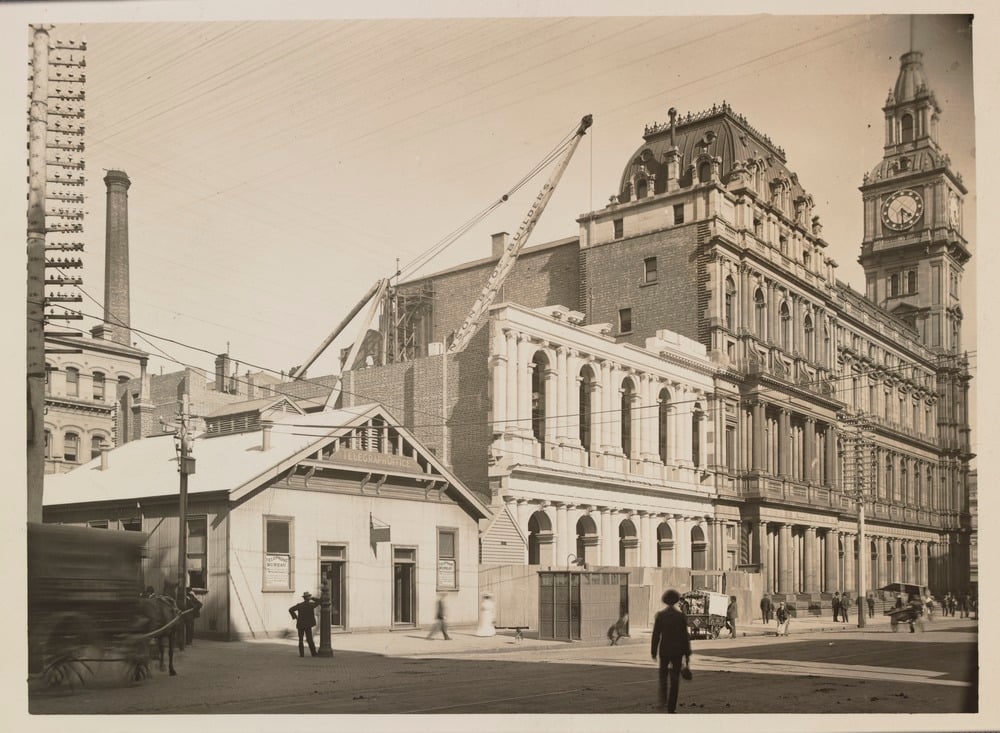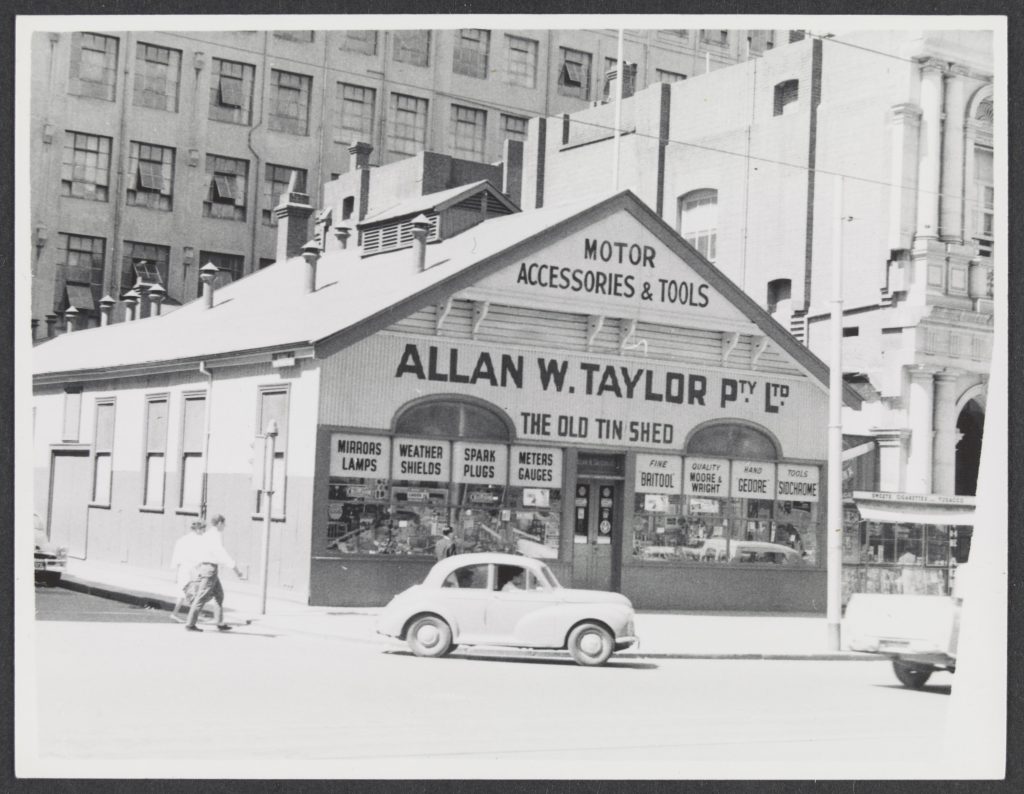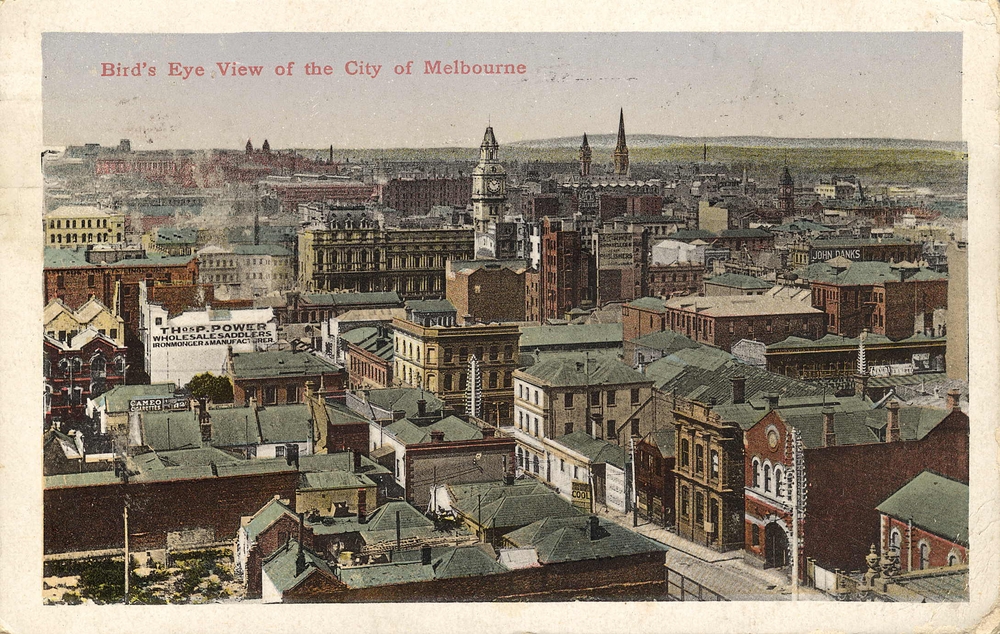In 1906, a little corrugated iron building was erected on the corner of Elizabeth Street and Little Bourke Street. The shed was intended to be a temporary home for the telegraph office until a more suitable location could be found.
 Melbourne general post office; H7926
Melbourne general post office; H7926
The arrival of the building went largely unnoticed. Melburnians had more important things to worry about – the advent of electric trams; Carlton’s ascendancy in the VFL grand final.
In 1907, the GPO was renovated and the telegraph officers were relocated to the main building. But the little corrugated iron building remained. In 1920, the building was leased out to a motor accessories firm.
 The old tin shed. Photograph by Wilfred Howard Hall. This work is in copyright; H2011.161/35
The old tin shed. Photograph by Wilfred Howard Hall. This work is in copyright; H2011.161/35
The years passed. The city around the building grew and changed.
Bird’s eye view of the city of Melbourne; H86.98/98
Grand new buildings began to appear on the city landscape.
 Manchester Unity building, corner Swanston and Collins Streets, Melbourne. Photograph by Lyle Fowler, Harold Paynting Collection; H92.20/122
Manchester Unity building, corner Swanston and Collins Streets, Melbourne. Photograph by Lyle Fowler, Harold Paynting Collection; H92.20/122
Melbourne was a city in a hurry. Rapid construction was de rigueur, with an emphasis on ‘massivity and permanence’ [1]
Regent theatre under construction; H92.374/27
People in the city began to talk. When are they going to get rid of that old tin shed? It’s old and it’s ugly. We don’t want it anymore.[2]
Rumours about the land began to swirl. It was said the site was blank on the original city plan and that nobody knew who owned the title. ‘Legend’ had it that the site was sold separately at an early land sale, before being resold to a ‘drunken sailor’. No written evidence of the transaction existed. (Age, 6 September 1933, p 11)
The Age, 8 January 1926, p.10
People began petitioning the Lands Office with false claims. Claims poured in from far and wide, from the vague, to the reminiscent, to the outright fanciful.
The Age, 21 January 1926, p. 11
While some were preoccupied with finding their fortune, others campaigned for the shed’s removal. Suggestions were proffered for its replacement.
‘Shade trees, lawns, and seats of good design would be a positive godsend in such a position,’ garden designer Edna Walling wrote in a letter to the Argus in 1934. ‘A cool place in which to rest, and the beauty of green foliage are so vital to a city’s amenities and so conspicuously absent in Melbourne’.
In 1935, it was announced that the shed would be demolished to make way for Post Office extensions. The city celebrated, but the plan came to nothing. [3]
By 1936 the controversy around the old tin shed was full blown. Historian A.S.Kenyon was so incensed by all the rumour and innuendo that he wrote to the Age to set the record straight.
As a matter of fact that allotment and the adjoining allotment, No 1, on which the post office itself is built, were reserved for the public at the beginning at the instance of Mr Robert Hoddle, surveyor in charge. At no time was either allotment offered to the public for sale or leasehold. (Age, 10 Jul 1937, p. 19)
 Melbourne, plan showing city allotments sold prior to separation, 1851
Melbourne, plan showing city allotments sold prior to separation, 1851
Despite Kenyon’s efforts, the controversy continued.
Debate reached the halls of federal parliament. In 1936, Labor MP E.J. Holloway called the building an ‘eyesore’ and urged the government to remove it. ‘The first place tourists go is the post office,’ he said, ‘and when they do so in Melbourne they are confronted by the old tin shed – a building which is a disgrace to the city.’ (Age, 13 May 1936, p 11)
Despite Melburnians’ best efforts, the Commonwealth government was unmoved.
Headline from the Sun news-pictorial, 20 August 1955, p 17
The shed survived for another 28 years before it was finally demolished in 1964.
 Melbourne Elizabeth Street Port Office. Demolition of the old tin shed.
Melbourne Elizabeth Street Port Office. Demolition of the old tin shed.
National Archives of Australia; B6295, 1043A
 Melbourne Elizabeth Street Port Office. Demolition of the old tin shed
Melbourne Elizabeth Street Port Office. Demolition of the old tin shed
National Archives of Australia; B6295, 1043C
References
[1] Hamann, Conrad, 2017, ‘Architecture’, eMelbourne, viewed 8 November 2017, <http://www.emelbourne.net.au/biogs/EM00083b.htm>
[2] ‘City “blot” is criticised. Tin shed should go council says’, Herald, 18 December 1933, p. 10
[3] ‘Old Tin Shed’ subject file, La Trobe Collection, State Library Victoria







My father worked at The Old Tin Shed, and made a model of it, probably in the 1970’s. The business moved to Little Bourke Street in the early 1960’s. The model was included in an exhibition by the Museum of Victoria in 1986.
Great research Sarah, if it was still standing one would presume Melbourne’s trendiest cafe/restaurant would be operating. What was old is now new !!
Another really interesting read!
I remember the ‘old tin shed’. Didn’t know the history – terrific research Sarah.
Thanks Lyndal!
My grandfather used to say that he owned it at one stage: no evidence to prove it though, unfortunately.
My grandfather claimed he held the deed to the Old Tin Shed. But the family were never sure.
I am sure there was a little park on there for awhile in the 70’s and 80’s. Where i used to go at lunchtime.
Quite right! My favourite lunch spot in those days.
Sarah,
My aunt told me that a Moylan owned it.
Is this so?
Hi Peter. No, to the best of my knowledge, historian A.S.Kenyon was right – the land always belonged to the Crown. The Assistant Registrar of the Title office agreed. Sarah
My Great Great Grandfather claimed he owned it as well – – even up to the 1920’s his grandson was claiming ownership from the city of Melb. (NASH family). Interestingly the Moylan family were also connected into the NASH and CARMICHAEL Families….
Lovely – as usual, Sarah – but with the tinted bird’s eye view of Melbourne, can you tell me which street that is, cutting diagonally across from the right hand corner? Hard to identify so many of the (long gone) buildings….
Hi Judy. Yes, Gordon is right I think. The street you are referring to is Lt. Bourke St. The building in the foreground ‘Thos. Power Wholesale Saddlers Ironmongers & Manufacturers’ is listed in the Sands & McDougall directory as being located at 398-400 Little Bourke Street during this time period. Sarah
Great little snippet of history, nice photographs.
Anyone else recall that long bank of telephone booths that used to be on that site in the 80’s? They fronted on to Little Bourke.
Oh, wow, yes I remember those phones! I worked at McGills opposite for 20 years and used to have my lunch in the little park on that site.
Yes, I’d forgotten about those phone boxes !
I remember the old tin shed. Thank you for all your research which is fascinating.
@ Judy, if you look at the online version of the bird’s eye view print, it looks as though the street you are querying is Lt. Bourke St, looking eastwards towards the front of the Post Office building.
The Philatelic Branch of the PMG was on the site as part of the GPO stamp sales branch – probably about 1970 – 75
Geday Ray O’H,
Long time no speak – we worked together at PMG HQ, Lines,225 Bourke St
in early 1970’s and latter briefly met once when you were a staff adviser for Brian Howe MP (Batman) in late 1980s?. I worked for, with, under, and around Graeme Campbell MP (Kalgooorlie) from 1991 to ’98…but I still use my PMG sturdy, black, standard issue umbrella I was given when I first started as an inter-office messenger based at the then PMG nat. HQ nerve centre at 199 William St in Jan 1970 and so became very familiar with all
PMG occupied CBD and elsewhere establishments. I too remember the small park/lunch oasis where ‘The Old Tin Shed’ used to be, opposite the
old Post Office Hotel watering hole, nudgenudgewinkwink!,I’m still in North Fitzroy – get in touch you old Ginger Meggs…and thanks Sarah
Great snippet on early Melb.No don’t remember the Tin Shed but recall the bank of telephone booths in a concrete public square. I made Wedding day arrangements from one of the phones in 1974. Thanks.
My father Peter Wyatt finished his working life as proprietor of Allan W Taylor Pty Ltd, long time tenant of The Old Tin Shed. The business sold motor accessories and tools. Peter joined the business as a teenager in approximately 1931 and retired as owner of the business, aged approximately 70 years, in the mid 1980s. Allan W Taylor Pty Ltd was his sole employer throughout his life.
When the Old Tin Shed was demolished, the business relocated to 248 Elizabeth Street, and subsequently to 369 Lt Bourke Street. In addition, the business also held premises in Lonsdale Street for a short period.
As a teenager I worked as a typist in the typing pool of the Postal Services Branch of the PMG’s Department on the first floor of the GPO building – from our office window we had a good view of the action in Elizabeth Street and our ears became attuned to the donging of the GPO clock especially as mid-day rang out! In years to come our typing pool became transformed into a glamorous coffee shop! Don’t know what’s there now!
For a colour photo of the Old Tin Shed from 1964, see the Luly Collection at the University of Melbourne: https://omeka.cloud.unimelb.edu.au/melbourne-history/items/show/279#?c=0&m=0&s=0&cv=0&z=-0.1069%2C0%2C1.2137%2C0.6925
What a terrific photo. Thanks Andrew! Sarah.
A photo of the Old Tin Shed will be appearing in my Spring Edition of Western and Central Kar Kulture E-News/magazine for its nostalgic value.
As a young boy helping at my dad’s church supplies shop in Elizabeth St, I would pass that shop on my way to errands at the GPO.Having and interest in motoring and building in those days, the memories stay with me.
Lovely piano music in the background. What is it?
Hi Jim, Thanks for your interest. I have asked our video producer which track he used, and will let you know when I have an answer. Sarah
Hello again Jim, the music used in the video is titled ‘Orange Leaves,’composed by Hayley Wood. It was sourced from the production music library we licence all our music from so it may not be available commercially. Sarah
In 1945/6 I used to walk through a narrow lane between the P>O> and whatever was on the other side(Myers)? towards Bourke Street on my way to Flinders street. As I entered the lane, there was a fruit-seller in a white coat. He wore a hat. He was my Uncle. I am now 93. Does anyone know if there are pictures of this.
Hi Angela, Thanks for your interest in our blog. I will log your question with our reference service and one of our librarians will get back to you. Sarah
Very interesting article. I remember being shown the Old Tin Shed when I was a young child and told that our family claimed to have ownership, but the title had been lost in a house fire. Evidently there was a court case, which our family contested but lost around c1900. My great great grandmother Catherine Stephens, who arrived in Melbourne with her husband Thomas in 1840, told stories of watching the bullock wagons getting bogged in Bourke St. where they had bought a block of land and built a house. They later went into hotels and had “The Cavan” in Queensbury St. and the “Kings Arms” at the top of Swanston St. The family names were Stephens, Abbott and Hoskin.
Does anyone know whether the old tin shed was used as accomodation for migrants? My uncle told me that my ancestors lived there temporarily when they arrived from Ireland in the 1860s. Was something there prior to the building being constructed in 1906? Thanks for any info.
Hi Justin, Thanks for your interest. I will log your question with our Ask a Librarian service, and one of our librarians will get back to you. Sarah
Tom Power was one of the founders of the Carlton Football Club in 1864.
He published The Footballer, the first annual on Australian Football.
McGills son George McGill was an early Carlton player and official.
John Danks plumbing supplies in Bourke St is shown. Carlton player Harry Guy worked there from an office junior to head the company’s Sydney operations.
Opposite Danks was Petherick Book Publishers one of the family, Julius Petherick played for Carlton.